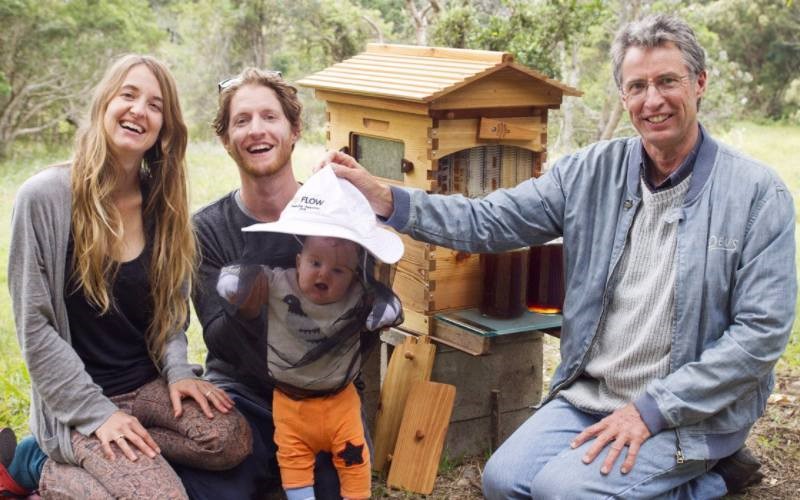Cedar Anderson, one of Australia’s greatest inventors and business innovators, talks about Flow Hive’s phenomenal success in revolutionising the worldwide beekeeping industry. Fundamental to that success has been Flow Hive’s commitment to doing the right thing and having a positive impact on the world.
This commitment to doing business for a positive purpose, is one aspect that greatly distinguishes the new breed of entrepreneurs and innovators at the forefront of creating value through disruption.
Cedar Anderson comments, “The new way of thinking is you do business for positive purpose. In the old way you make as much money as you can and don’t care how. You then give a bit away at the end so you don’t feel so bad. The new way is, from square one, what you are doing makes a positive impact.”
In the case of Beeinventive, that positive impact has made huge business sense.
The Flow story
Cedar and his father Stuart are beekeepers from Byron Bay. They devoted years of hardwork to develop a hive that allowed honey to be harvested without opening the hive.
As well as extracting honey in less time than tradition beekeping techniques, the Flow Hive is also less stressful on the bees. It eliminates the need to smoke them, dismantle the hive and remove the honeycomb. Cedar comments, “The Flow Hive was the first major change in beekeeping technology for 50 years. That innovation lent itself very well to the digital world – when you have something new and different people want to share it.”
“At the time the plight of the bee was on people’s minds. When, out of nowhere, we dropped our video highlighting the invention, on a pretty modest Facebook page, we got a million views in 30 hours.”
Cedar and his dad Stuart decided to crowdfund their innovation through Indiegogo. “The pre-launch video built a marketing and email list. We wanted 1000 email addresses and by the end of the first week we had 70,000 emails on the list and 50,000 Facebook likes”.
When they launched on 23rd February 2015, Indiegogo crashed several times from people refreshing. They reached their target of $70,000 in seven minutes. In two hours they broke a crowdfunding record getting to a million dollars in two hours. They went on to raise $US12.2m in 6 weeks.
They had 25,000 Flow Hive pre-sales to make and shift before Christmas.
And it didn’t stop there, orders kept flooding in – another 10,000 more to make for the following January and February. Cedar’s first child was born in the middle of all this. Two years on, Flow Hives are being distributed globally by Amazon, eBay and other on-line traders.
Building an industry
The ease of harvesting honey using Flow Hive has led to a rapid rise in the number of beekeepers around the globe. Flow has encouraged this trend by developing a support team to answer questions by email and phone. Cedar weekly answers questions live on Facebook. Their Facebook site is jam packed with advice on beekeeping.
“We didn’t know people were so interested” says Cedar “We created customer wants by providing a better innovation that spoke to people’s care for the environment. It is a fast and furious world out there. If something isn’t right you hear about it instantly and you have to actively address it immediately or you get a negative social media storm.”
Creating Brand Loyalty by doing good
They use their positive media presence to promote causes close to the hearts of their followers.
For example, when Vanuatu was hit by a cyclone, Flow used their big audience to raffle off a Flow Hive and raised $97,000 in three days with $5 raffle tickets. One month later they raised $130,000 in four days for victims of the Nepal earthquake. “All along the way we are trying to think creatively – how can we have a bigger impact beyond just beekeeping? There is so much more we can easily do”.
“Pollinator house” was a result of this thinking. Made from the offcuts of Flow Hives, pollinator houses are homes for solitary bees and can easily be used in urban areas to help regenerate bee communities. All of the profits go to habitat protection and restoration.
While Cedar’s passion for both beekeeping and the environment are clear, he says that, “Thinking about it purely from a business perspective it is branding. Our aim is that that even when we are dead and gone you can’t shake off the positive world stuff or the brand would become worthless. The effect is branding”.
“There are companies now (such as Who Gives a Crap toilet paper) that can only be successful by doing the right thing. They give 50% of their profits to building toilets in disadvantaged communities. The business benefit is, an otherwise “me-too” product builds an avid social media customer base.”
“A lot of companies are cottoning on that they need some aspect of social enterprise or positive environmental impact or they just won’t be in the game. Although this makes sense from a business perspective, to work;it must come from a place of legitimately wanting to have a positive impact in the world. When you are on your deathbed you can then say, ‘Wow, look how big I built my company and look at the positive impact my company has made on the world’.”

